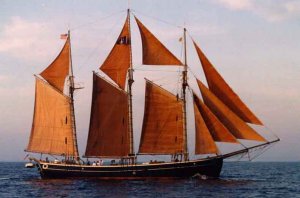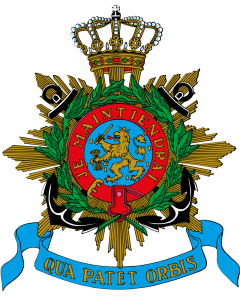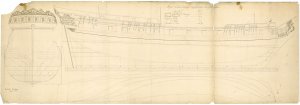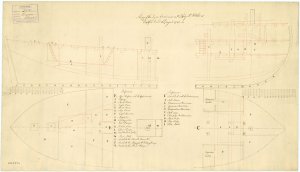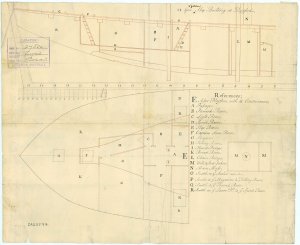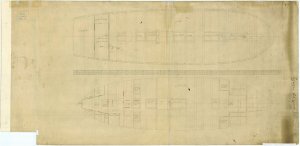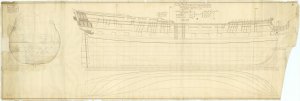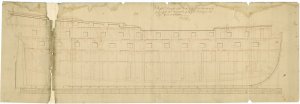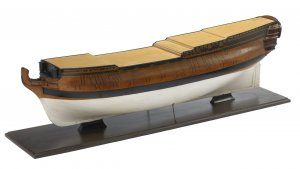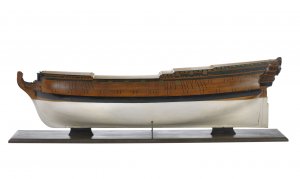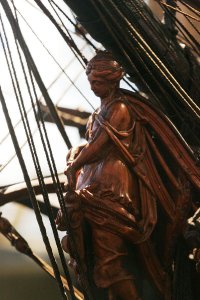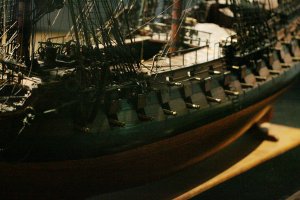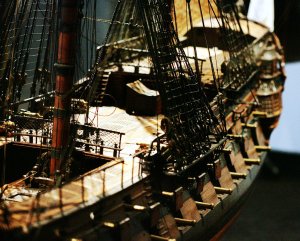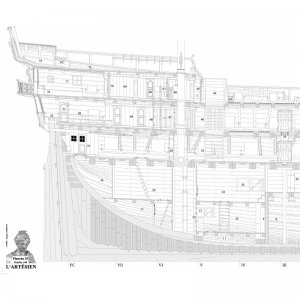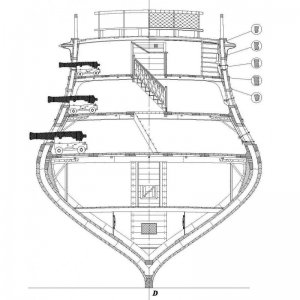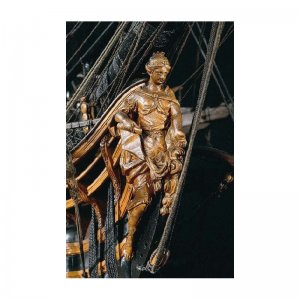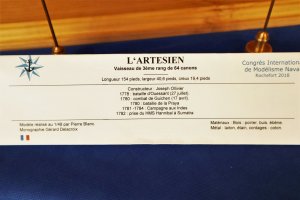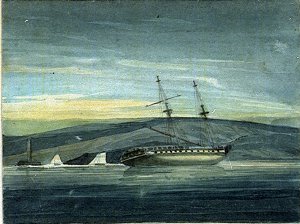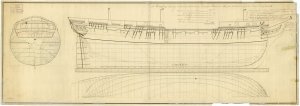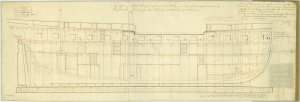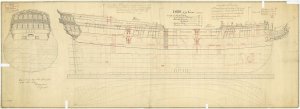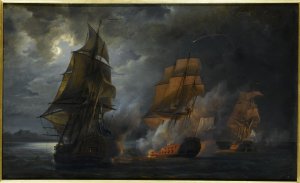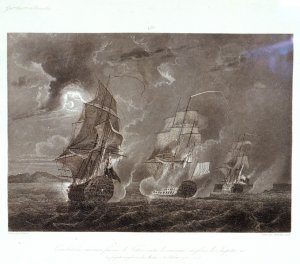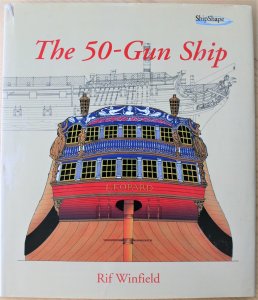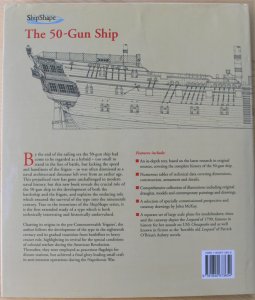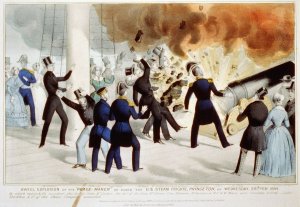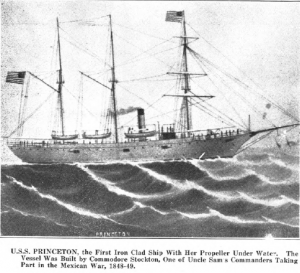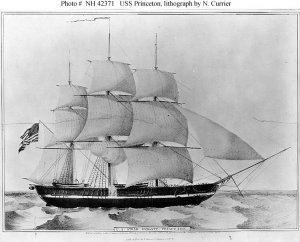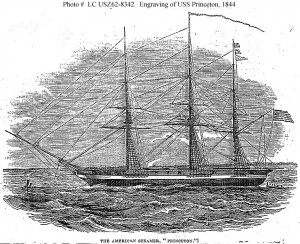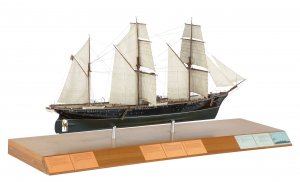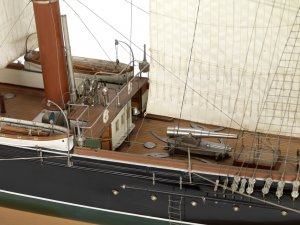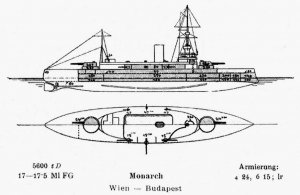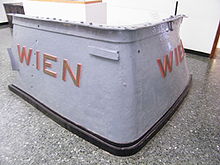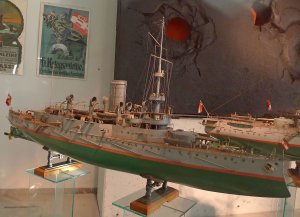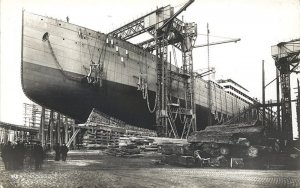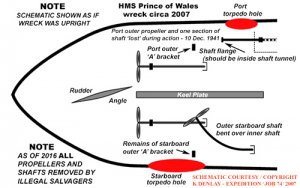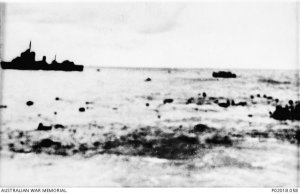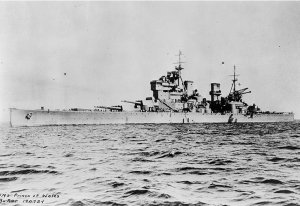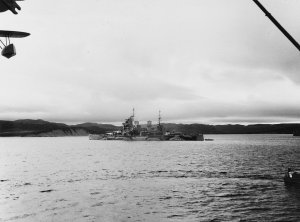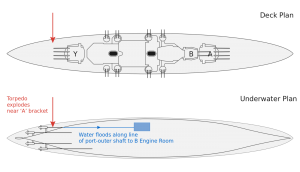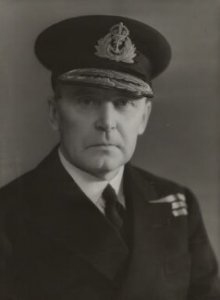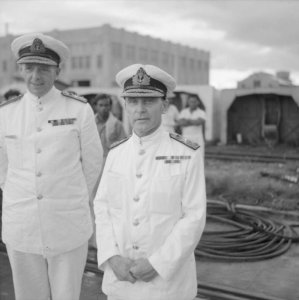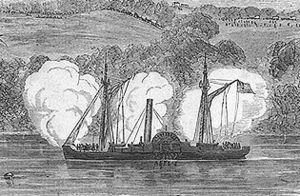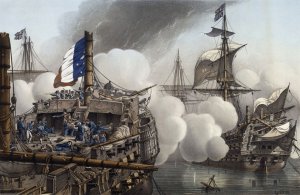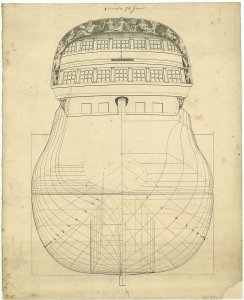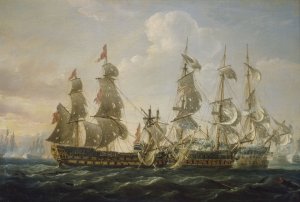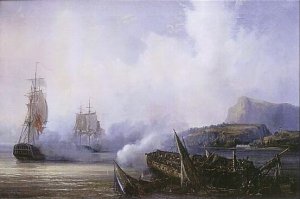Today in Naval History - Naval / Maritime Events in History
9 December 1905 – Launch of Greek Lemnos, sometimes spelled Limnos (Greek: Θ/Κ Λήμνος), a 13,000 ton Mississippi-class battleship
Lemnos, sometimes spelled Limnos (Greek: Θ/Κ Λήμνος), was a 13,000 ton Mississippi-class battleship originally built by the United States Navy in 1904–1908. As Idaho, she was purchased by the Greek Navy in 1914 and renamed Lemnos, along with her sister Mississippi, renamed Kilkis. Lemnos was named for the Battle of Lemnos, a crucial engagement of the First Balkan War. Armed with a main battery of four 12 in (305 mm) guns, Lemnos and her sister were the most powerful vessels in the Greek fleet.

Greek battleship Lemnos and torpedo boat Dafni at Constantinople (today İstanbul) 1919.
The ship saw limited action during World War I. Greece's pro-German monarch, Constantine I opted to remain neutral until October 1916, when pressure from the Triple Ententeforced him to abdicate in favor of a pro-Entente government. For the remainder of the war, Lemnos operated solely as a harbor defense ship. In the aftermath of World War I, she saw service during the Allied intervention in the Russian Civil War and the Greco-Turkish War of 1919–1922. During the war with Turkey, Lemnos supported Greek landings in Turkey and participated in the final Greek sea-borne withdrawal in 1922. She remained in service until 1932, when she was used as a barracks ship and subsequently disarmed. During the German invasion of Greece in 1941, she and her sister were sunk in Salamis by German Junkers Ju 87 dive bombers. The two ships were ultimately raised and broken up for scrap after the end of the war.
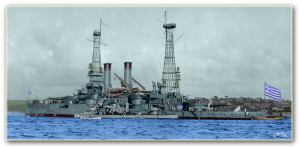
Design
Main article: Mississippi-class battleship
Lemnos was 382 feet (116 m) long overall and had a beam of 77 ft (23 m) and a draft of 24 ft 8 in (7.52 m). She displaced 13,000 metric tons (13,000 long tons; 14,000 short tons) as designed and up to 14,465 t (14,237 long tons; 15,945 short tons) at full combat load. The ship was powered by two-shaft vertical triple expansion engines and eight coal-fired Babcock & Wilcox boilers rated at 10,000 indicated horsepower (7,500 kW) and a top speed of 17 knots (20 mph; 31 km/h). Lattice masts were installed in 1909. She had a crew of 744 officers and enlisted men.
The ship was armed with a main battery of four 12 in (305 mm) L/45 guns in two twin turrets, one on each end of the superstructure. Eight 8 in (203 mm) L/45 guns were mounted in four twin turrets, two on each side of the vessel amidships. The secondary battery was rounded out with eight 7 in (178 mm) L/45 guns mounted individually in casemates along the length of the hull. Close-range defense against torpedo boats was provided by a battery of twelve 3 in (76 mm) L/50 guns, six 3-pounder guns and two 1-pounder guns. The ship's armament system was completed by two 21 in (533 mm) torpedo tubes submerged in her hull.[1] Lemnos and Kilkis were the most powerful vessels in the Greek Navy.

Service history
See also: USS Idaho (BB-24)
Laid down on 12 May 1904, the ship was launched on 9 December 1905 and commissioned into the United States Navy on 1 April 1908 as USS Idaho. Greece became engaged in a naval arms race with the Ottoman Empire at the time; in 1910 the Ottomans had purchased a pair of German pre-dreadnoughts (renamed Barbaros Hayreddin and Turgut Reis) and ordered dreadnought battleships from Britain in 1911 and 1914. The Greek Navy ordered the dreadnought Salamis from Germany in 1913 and the dreadnought Basileus Konstantinos from France. As a stop-gap measure, the Greeks purchased Mississippi and Idaho from the US Navy, for the sum of $12,535,276.58, on 30 June 1914. The two ships were transferred to the Greek Navy in Newport , Virginia the following month, Idaho and Mississippi becoming Lemnos and Kilkis, respectively. Lemnos and Kilkisquickly left the United States after their transfer in July 1914, due to the rising tensions in Europe following the assassination of Archduke Franz Ferdinand of Austria the previous month.
, Virginia the following month, Idaho and Mississippi becoming Lemnos and Kilkis, respectively. Lemnos and Kilkisquickly left the United States after their transfer in July 1914, due to the rising tensions in Europe following the assassination of Archduke Franz Ferdinand of Austria the previous month.
At the outbreak of World War I in at the end of the month, Greece's pro-German monarch, Constantine I, decided to remain neutral. The Entente powers landed troops in Salonika in 1915, which was a source of tension between France and Greece. Ultimately, the French seized the Greek Navy on 19 October 1916 (see Noemvriana and National Schism).[8]Lemnos was reduced to a skeleton crew and had the breech blocks for her guns removed to render them inoperable. All ammunition and torpedoes were also removed. Ultimately, a pro-Entente government under Prime Minister Eleftherios Venizelos replaced Constantine and declared war on the Central Powers. Lemnos, however, did not see active service with Greece's new allies,[8] and instead was used solely for harbor defense until the end of the war.
After the end of World War I, Lemnos joined the Allied intervention in the Russian Civil War and served with the Crimean Expedition. There, she aided the White Russians against the Communists. In April 1919, Lemnos was present in Kaffa Bay, where she provided gunfire support to the Volunteer Army. On 22 April, aerial reconnaissance reported that the Red Army was massing in the town of Vladislovovka; Lemnos and the British light cruiser HMS Caradoc bombarded the town, forcing the Soviet forces to withdraw. She then saw service during the Greco-Turkish War, where she supported landings to seize Ottoman territory. The Ottoman Navy had been interned by the Allies after the end of World War I, and so provided no opposition to the Greek Navy's activities.
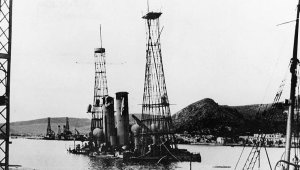
Kilkis and Lemnos sunk after German air attack, 1941.
In February 1921, Lemnos was stationed in Smyrna to support the occupation of the city. Operations came to a close in September 1922 when the Greek Army was forced to evacuate Smyrna by sea, along with a sizable number of civilians from Asia Minor. The fleet transported a total of 250,000 soldiers and civilians during the evacuation. Lemnos departed Smyrna on the evening of 8 September with her sister Kilkis. While en route from Smyrna to mainland Greece, Captain Dimitrios Fokas, the commander of Lemnos, formed a Revolutionary Committee with Nikolaos Plastiras and Stylianos Gonatas, two colonels who supported Venizelos, who had been ousted in 1920. The men launched the 11 September 1922 Revolution, and other vessels in the fleet mutinied in support of the coup. King Constantine I was forced to abdicate in favor of his son, George II.
In 1932, Lemnos was placed in inactive reserve; sections of her armor plate was removed to build fortifications on the island of Aegina. She was disarmed in 1937 and thereafter used as a barracks ship. On 28 October 1940, Italy invaded Greece, initiating the Greco-Italian War as part of the Italian dictator Benito Mussolini's expansionist ambitions. The Greek army quickly defeated the Italians and pushed them back to Albania. Less than two weeks later, the Italian fleet was badly damaged in the British Raid on Taranto, which significantly reduced the threat the Italian Regia Marina posed to the Greek fleet. Lemnos remained out of service, but spare guns from she and Kilkis were employed as coastal batteries throughout Greece. On 6 April 1941, the German Wehrmacht invaded Greece to support its Italian ally in the stalemated conflict. The hulk of Lemnos was bombed in Salamis Naval Base by Junkers Ju 87 dive bombers on 23 April. The ship was beached to prevent her from sinking; her wreck was broken up after the end of the war.
https://en.wikipedia.org/wiki/Greek_battleship_Lemnos
9 December 1905 – Launch of Greek Lemnos, sometimes spelled Limnos (Greek: Θ/Κ Λήμνος), a 13,000 ton Mississippi-class battleship
Lemnos, sometimes spelled Limnos (Greek: Θ/Κ Λήμνος), was a 13,000 ton Mississippi-class battleship originally built by the United States Navy in 1904–1908. As Idaho, she was purchased by the Greek Navy in 1914 and renamed Lemnos, along with her sister Mississippi, renamed Kilkis. Lemnos was named for the Battle of Lemnos, a crucial engagement of the First Balkan War. Armed with a main battery of four 12 in (305 mm) guns, Lemnos and her sister were the most powerful vessels in the Greek fleet.

Greek battleship Lemnos and torpedo boat Dafni at Constantinople (today İstanbul) 1919.
The ship saw limited action during World War I. Greece's pro-German monarch, Constantine I opted to remain neutral until October 1916, when pressure from the Triple Ententeforced him to abdicate in favor of a pro-Entente government. For the remainder of the war, Lemnos operated solely as a harbor defense ship. In the aftermath of World War I, she saw service during the Allied intervention in the Russian Civil War and the Greco-Turkish War of 1919–1922. During the war with Turkey, Lemnos supported Greek landings in Turkey and participated in the final Greek sea-borne withdrawal in 1922. She remained in service until 1932, when she was used as a barracks ship and subsequently disarmed. During the German invasion of Greece in 1941, she and her sister were sunk in Salamis by German Junkers Ju 87 dive bombers. The two ships were ultimately raised and broken up for scrap after the end of the war.

Design
Main article: Mississippi-class battleship
Lemnos was 382 feet (116 m) long overall and had a beam of 77 ft (23 m) and a draft of 24 ft 8 in (7.52 m). She displaced 13,000 metric tons (13,000 long tons; 14,000 short tons) as designed and up to 14,465 t (14,237 long tons; 15,945 short tons) at full combat load. The ship was powered by two-shaft vertical triple expansion engines and eight coal-fired Babcock & Wilcox boilers rated at 10,000 indicated horsepower (7,500 kW) and a top speed of 17 knots (20 mph; 31 km/h). Lattice masts were installed in 1909. She had a crew of 744 officers and enlisted men.
The ship was armed with a main battery of four 12 in (305 mm) L/45 guns in two twin turrets, one on each end of the superstructure. Eight 8 in (203 mm) L/45 guns were mounted in four twin turrets, two on each side of the vessel amidships. The secondary battery was rounded out with eight 7 in (178 mm) L/45 guns mounted individually in casemates along the length of the hull. Close-range defense against torpedo boats was provided by a battery of twelve 3 in (76 mm) L/50 guns, six 3-pounder guns and two 1-pounder guns. The ship's armament system was completed by two 21 in (533 mm) torpedo tubes submerged in her hull.[1] Lemnos and Kilkis were the most powerful vessels in the Greek Navy.

Service history
See also: USS Idaho (BB-24)
Laid down on 12 May 1904, the ship was launched on 9 December 1905 and commissioned into the United States Navy on 1 April 1908 as USS Idaho. Greece became engaged in a naval arms race with the Ottoman Empire at the time; in 1910 the Ottomans had purchased a pair of German pre-dreadnoughts (renamed Barbaros Hayreddin and Turgut Reis) and ordered dreadnought battleships from Britain in 1911 and 1914. The Greek Navy ordered the dreadnought Salamis from Germany in 1913 and the dreadnought Basileus Konstantinos from France. As a stop-gap measure, the Greeks purchased Mississippi and Idaho from the US Navy, for the sum of $12,535,276.58, on 30 June 1914. The two ships were transferred to the Greek Navy in Newport
 , Virginia the following month, Idaho and Mississippi becoming Lemnos and Kilkis, respectively. Lemnos and Kilkisquickly left the United States after their transfer in July 1914, due to the rising tensions in Europe following the assassination of Archduke Franz Ferdinand of Austria the previous month.
, Virginia the following month, Idaho and Mississippi becoming Lemnos and Kilkis, respectively. Lemnos and Kilkisquickly left the United States after their transfer in July 1914, due to the rising tensions in Europe following the assassination of Archduke Franz Ferdinand of Austria the previous month.At the outbreak of World War I in at the end of the month, Greece's pro-German monarch, Constantine I, decided to remain neutral. The Entente powers landed troops in Salonika in 1915, which was a source of tension between France and Greece. Ultimately, the French seized the Greek Navy on 19 October 1916 (see Noemvriana and National Schism).[8]Lemnos was reduced to a skeleton crew and had the breech blocks for her guns removed to render them inoperable. All ammunition and torpedoes were also removed. Ultimately, a pro-Entente government under Prime Minister Eleftherios Venizelos replaced Constantine and declared war on the Central Powers. Lemnos, however, did not see active service with Greece's new allies,[8] and instead was used solely for harbor defense until the end of the war.
After the end of World War I, Lemnos joined the Allied intervention in the Russian Civil War and served with the Crimean Expedition. There, she aided the White Russians against the Communists. In April 1919, Lemnos was present in Kaffa Bay, where she provided gunfire support to the Volunteer Army. On 22 April, aerial reconnaissance reported that the Red Army was massing in the town of Vladislovovka; Lemnos and the British light cruiser HMS Caradoc bombarded the town, forcing the Soviet forces to withdraw. She then saw service during the Greco-Turkish War, where she supported landings to seize Ottoman territory. The Ottoman Navy had been interned by the Allies after the end of World War I, and so provided no opposition to the Greek Navy's activities.

Kilkis and Lemnos sunk after German air attack, 1941.
In February 1921, Lemnos was stationed in Smyrna to support the occupation of the city. Operations came to a close in September 1922 when the Greek Army was forced to evacuate Smyrna by sea, along with a sizable number of civilians from Asia Minor. The fleet transported a total of 250,000 soldiers and civilians during the evacuation. Lemnos departed Smyrna on the evening of 8 September with her sister Kilkis. While en route from Smyrna to mainland Greece, Captain Dimitrios Fokas, the commander of Lemnos, formed a Revolutionary Committee with Nikolaos Plastiras and Stylianos Gonatas, two colonels who supported Venizelos, who had been ousted in 1920. The men launched the 11 September 1922 Revolution, and other vessels in the fleet mutinied in support of the coup. King Constantine I was forced to abdicate in favor of his son, George II.
In 1932, Lemnos was placed in inactive reserve; sections of her armor plate was removed to build fortifications on the island of Aegina. She was disarmed in 1937 and thereafter used as a barracks ship. On 28 October 1940, Italy invaded Greece, initiating the Greco-Italian War as part of the Italian dictator Benito Mussolini's expansionist ambitions. The Greek army quickly defeated the Italians and pushed them back to Albania. Less than two weeks later, the Italian fleet was badly damaged in the British Raid on Taranto, which significantly reduced the threat the Italian Regia Marina posed to the Greek fleet. Lemnos remained out of service, but spare guns from she and Kilkis were employed as coastal batteries throughout Greece. On 6 April 1941, the German Wehrmacht invaded Greece to support its Italian ally in the stalemated conflict. The hulk of Lemnos was bombed in Salamis Naval Base by Junkers Ju 87 dive bombers on 23 April. The ship was beached to prevent her from sinking; her wreck was broken up after the end of the war.
https://en.wikipedia.org/wiki/Greek_battleship_Lemnos



